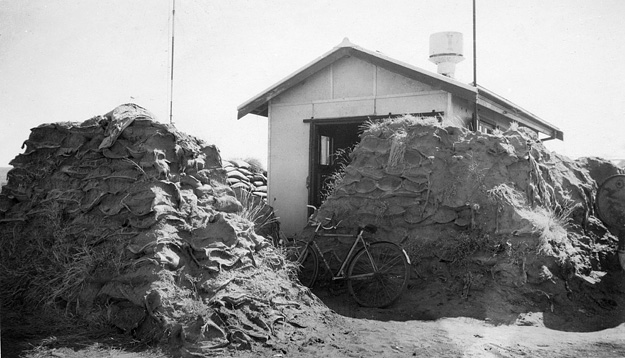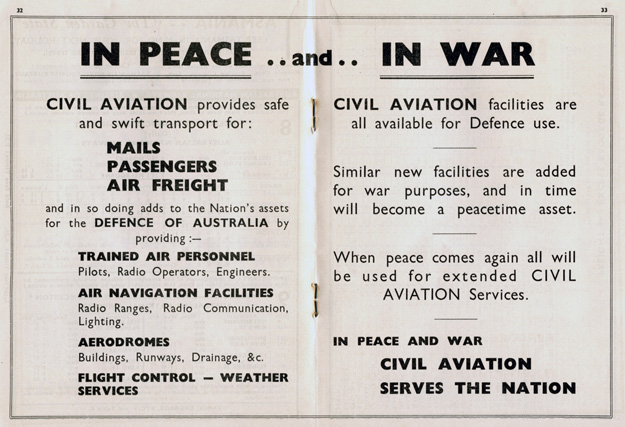DCA's Role in the Second World War
by
Roger Meyer
The Department of Civil Aviation’s
role in the Second World War is a surprisingly broad subject, as
article reveals.
As the war clouds gathered over Europe, governments prepared for the coming emergency. In Australia, civil aviation’s role was recognised when, on 26 April 1939, J.V. Fairbairn became both Minister for Civil Aviation and Minister assisting the Minister for Defence. When the Defence portfolio was divided on 13 November, Fairbairn became Minister for the Air (i.e. RAAF) while also retaining the Civil Aviation portfolio.
How prepared was DCA for the war?
By June 1939 DCA was responsible for 71 Government Aerodromes and 147 emergency landing grounds. There were 215 local aerodromes licensed. Advances had been made in airway and aerodrome lighting, including rotating beacons and obstruction and boundary lights. Strip maps for pilots were being produced. Aeronautical radio facilities were of two types; communications and navigation. Permanent Aeradio stations were being constructed at 17 sites, with temporary facilities at six more. The AWA Coastal Radio Service was, at this time, also used for air-to-ground communications. Ultra High Frequency Lorenz 33 MHz radio range beacons existed at Brisbane, Kempsey, Sydney, Canberra, Melbourne, Launceston, Hobart, Nhill, Adelaide and Perth.
Air Traffic Control had also begun. In March 1937, Aerodrome Control Officers were appointed at Archerfield, Mascot, Essendon and Parafield. Meteorological facilities were also being provided, with full forecasting stations at 12 airports, and secondary stations at 11 more.
So, when war came much had already been done to put in place a civil aviation infrastructure, but much more was needed and DCA was immediately involved in providing it.
Organisation and personnel
The enormous increase in the Department’s responsibilities and activities led naturally to an increase in personnel. The increase resulted, in part, from the many officers who enlisted or were loaned to the defence departments.
In June 1939, there had been 251 officers and employees. There were 275 by June 1940 and 524 by June 1942. On 20 April 1942, the Department was declared a ‘protected undertaking’ under the National Security (Manpower) Regulations. This meant that staff could not leave the Department without special authority. During the war 77 officers of DCA enlisted in the armed forces for full-time service. Eight of these men gave their lives. By 30 June 1946, all but two of the survivors had resumed duty with the Department.
On 13 August 1940 Minister Fairbairn was killed while a passenger on a RAAF Hudson aircraft which crashed near Canberra Airport. Also lost were the Minister for the Army, the Chief of the General Staff, the Vice-President of the Executive Council, a staff officer, Fairbairn’s private secretary, and the aircraft crew.
Fairbairn was followed as Minister in quick succession by Arthur Fadden and Jack McEwan. On 7th October 1941, when the Curtin government took office, A.S. Drakeford became minister. He remained a very effective minister until 1949.
A.B. Corbett was Director-General at the beginning, was almost due to retire, but because of the emergency, his appointment was regularly extended for short periods until 17 February 1944 when Daniel McVey was appointed. As McVey could not take up duty until 5 August, Corbett soldiered on before finally retiring on 4th August. Much of the burden throughout the war was borne by the Assistant Director-General, E.C. Johnston and a small group of senior officers, including the Chief Electrical Engineer, R.M. Badenach, the chief Aeronautical Engineer, A.G. Berg, and the Chief Inspector, Ground Organisation, A.R. McComb.
Australia attacked
On Tuesday, 19 February 1942, the Japanese mounted a heavy bombing raid on Darwin, the first on Australian mainland soil. The civil aerodrome at Parap received a few minutes warning. The ground staff evacuated their offices and took shelter in slit trenches. The Aeradio staff rushed to the radio room to carry out their emergency procedures. An ‘air raid in progress’ signal – QQQ QQQ QQQ de VZDN – was sent out, and repeated by Daly Waters. This was to turn back all civil aircraft which might be on their way to Darwin. The operators then sought shelter in the slit trenches.
At the end of the first raid, staff came back to put out the fires. Unfortunately the aerodrome fire tender was ablaze and the emergency power plant was badly damaged. In the Aeradio room the ceiling had been brought down, and the room was littered with broken valves. The control lines to the transmitter were open-circuited and all the radio equipment was unworkable. Radio staff then drove to the Darwin Coastal Radio Station to report the damage to Melbourne. This message was the first detailed news of the raid received by the rest of Australia.
While this message was being sent a second raid occurred. The radio staff then went to the '11 mile' transmitter site and opened an aircraft watch, backed by the AWA Coastal Radio Station. By early in the afternoon, Darwin Aeradio was back in business.
Bruce Acland, a DCA Aeradio operator (who later received a King's Commendation for Brave Conduct in recognition of his work during the raid), recalled: "The few days after the first big raid are a blur in the memory. We literally worked until we dropped, twenty or more hours at a stretch. I was involved mainly in setting up a station using aircraft equipment and batteries with a petrol charger at a deserted Chinese shop near the civil 'drome. Some of the others were dismantling the transmitters at the 'Eleven Mile' [site] and when they had completed this they took them by train to Katherine. During all this period VZDN was still on the air. Our staff dropped down to three Aeradio and one flight check officer, and the deserted Chinese shop became Darwin Aeradio. We shifted into the OIC’s residence near the civil 'drome getting what food we could from neighbouring houses and the RAAF Mess store on the aerodrome."
Much of the attack on Darwin was aimed at the harbour where the Flying Boat Base was located. The Base was under the control of DCA officer William Wake. During the first attack, five merchant ships were sunk and a further 11 vessels damaged. Hidden by the smoke of burning ships, the QEA flying boat Camilla (VH-ADU) received only minor shrapnel holes. Between the raids she was safely flown out and returned the next day to evacuate the company’s staff.
DCA Coxswain John Waldie set about rescuing survivors in the departmental launch CA22. On the first two trips he was accompanied by Boathand Ray Crocker. He then made at least three trips alone. Waldie is known to have saved over one hundred men. William Wake, OIC, was knocked down by a bomb blast near the DCA Control Building but although badly concussed, he remained on duty. Wake and a boathand took another departmental launch out rescue survivors and later toured the harbour with Waldie. Flying boat operations ceased at Darwin after the raid, and after further raids the Base staff were withdrawn.
For some weeks there were no further bombing raids, only aerial reconnaissance and fighter strafing attacks. Bombing attacks then occurred on 19, 26, 28 and 31 March. Aeradio moved to a tin shanty adjacent to Parap Police Station. The operators dug a slit trench near the hut and fitted it so they could key their transmitter and listen on one of the receivers while in the trench. There was a telephone to flight section control and the anti-aircraft batteries.
Above: The Qantas hangar, occupied by Guinea Airways, at Darwin's Parap airport after being
bombed in 1942. Note the bomb crater in the foreground and the windsock
still standing on the hangar roof.
Attacks spread
Following the bombing of Darwin, Wyndham, in north-western Australia also received attention from the Japanese. Rod Torrington was the Aeradio operator at Wyndham, and recalls: "March 3rd 1942 dawned, and at about 10am down came MacRobertson-Miller’s Lockheed 10 from Darwin on its way to Perth. Jimmy Woods was the Captain of the aircraft. While they were refuelling an RAAF Dragon came in. When refuelling was finished, they all got in the aeroplane and Jimmy went to take off as normal. I went over to Aeradio and while I was waiting for Jimmy’s departure signal, to my amazement, one of the RAAF people went racing past Aeradio towards the bush and he was really going at a rate of knots. As there was nothing to attract one in that direction, I thought I’d go to the door and see what it was all about. When I reached the door, I could see this line of Zeros (Japanese fighters) coming straight for the aerodrome and Aeradio. With the noise of a couple of receivers going, I hadn’t heard the Zeros coming. I then decided I would follow him in the same direction because I could see a couple of Zeros in line coming towards us. I wore a white shirt, white shorts and white socks in those days, and there I was trying to crouch down under a small bush with few leaves on it, and in full view of the Zero pilots. I never again wore a white shirt and white shorts after that!"
"Looking back, I could see the big stack of 44-gallon drums, which had arrived from Wyndham a week before, on fire. The hangar and the RAAF Dragon were also burning but, amazing as it was, Aeradio wasn’t on fire. The 20mm cannon and ordinary 7mm shells had gone through the Aeradio hut. Fortunately they had gone through fairly high, above the radio equipment but had minced up the hurricane lamps hanging from the rafters. Fortunately, not one bit of the Aeradio equipment had been damaged, so I came back and put it all on the air again. I contacted Jimmy Woods, who had just got out of sight before the Japanese came into the area. He was very lucky; if he had waited another five minutes he would not have had an aircraft to go home in. That was the first air raid on Wyndham aeradio. It was all rather frantic."

Above: Wyndham
Aeradio after the Japanese raid. Note the bicycle propped out the front ready for
a quick getaway!
Rod Torrington's
telegram to DCA Head Office in Melbourne following a subsequent attack read as
follows:
From
WYNDHAM 5.40 p.m. 23/3
To AVIAT [DCA HO]
DROME BOMBED 7 TWIN ENGINED PLANES 0945 W.S.T. 23RD ALL RUNWAYS DAMAGED (.) 900 YARDS 119 DEGREES SERVICEABLE (.) APPROXIMATELY 50 BOMBS (.) 1110 W.S.T. DROME STRAFFED 4 ZERO TYPE FIGHTERS NO APPRECIABLE DAMAGE NO CASUALTIES
TORRINGTON
This telegram was received by phone at DCA Head Office at 0130 on the morning of 24 March 1942.
Below: This ad from Gordon's Air Guide for January 1943 highlights the role played by Civil Aviation in the defence of Australia during the Second World War.

Acknowledgement: Some of the material in this article is from an unpublished
manuscript written by former Historical Officer James Walker.
(Photos: CAHS collection)
Click here to read a contemporary report of Aeradio in the bombing of Darwin
Back to the main General Organisational History index
If
this page appears without menu bars at top or left, click
here